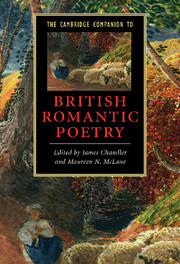Book contents
- Frontmatter
- Introduction: The companionable forms of Romantic poetry
- 1 The living pantheon of poets in 1820: pantheon or canon?
- 2 Romantic poetry and antiquity
- 3 Romantic meter and form
- 4 Romantic poetry and the standardization of English
- 5 Thinking in verse
- 6 Romantic poetry and the romantic novel
- 7 Wordsworth’s great Ode: Romanticism and the progress of poetry
- 8 Romantic poetry, sexuality, gender
- 9 Poetry, peripheries and empire
- 10 Romantic poetry and the science of nostalgia
- 11 Rethinking Romantic poetry and history: lyric resistance, lyric seduction
- 12 The medium of Romantic poetry
- 13 Romantic poets and contemporary poetry
- Index
- Series List
4 - Romantic poetry and the standardization of English
Published online by Cambridge University Press: 28 November 2008
- Frontmatter
- Introduction: The companionable forms of Romantic poetry
- 1 The living pantheon of poets in 1820: pantheon or canon?
- 2 Romantic poetry and antiquity
- 3 Romantic meter and form
- 4 Romantic poetry and the standardization of English
- 5 Thinking in verse
- 6 Romantic poetry and the romantic novel
- 7 Wordsworth’s great Ode: Romanticism and the progress of poetry
- 8 Romantic poetry, sexuality, gender
- 9 Poetry, peripheries and empire
- 10 Romantic poetry and the science of nostalgia
- 11 Rethinking Romantic poetry and history: lyric resistance, lyric seduction
- 12 The medium of Romantic poetry
- 13 Romantic poets and contemporary poetry
- Index
- Series List
Summary
Rather than trying to understand the historical relation between present-day English and English of the Romantic period, literary scholars have rarely thought much about English at all. Instead, they have concentrated on more abstract and seemingly weightier issues, such as Romantic debates about how language originated and how it related to the operations of the mind. This philosophical focus on language masks the fact that Romantic poets did not necessarily share contemporary critics' ability to take English as a given. They confronted considerable uncertainty about just how to write in English because the ways that the language was defined, taught, analyzed, judged, and printed changed dramatically in the second half of the eighteenth century. Linguistic historians usually describe these changes as “standardization” or “prescriptivism,” the process whereby philologists, grammarians, lexicographers, and orthoepists (codifiers of correct pronunciation) developed rules about right and wrong English usage. While guides to English had existed for centuries, they had largely been designed for foreigners wanting to learn English. The eighteenth century saw the rise of books of usage for native speakers. They aimed to teach readers not how to speak and write English, but how to speak and write English correctly.
Great Britain during this period was an unstable political entity, sometimes subject to violent internal divisions, as in the American War of Independence and the 1798 Irish rebellion, and more generally characterized by significant and widespread variation from region to region, and even from county to county.
- Type
- Chapter
- Information
- The Cambridge Companion to British Romantic Poetry , pp. 76 - 97Publisher: Cambridge University PressPrint publication year: 2008
- 1
- Cited by

